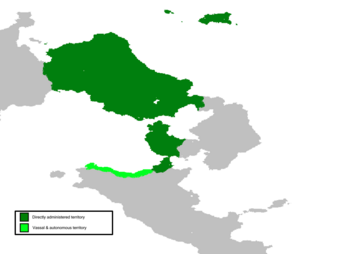Bilekian Empire: Difference between revisions
No edit summary |
No edit summary |
||
| Line 30: | Line 30: | ||
| government_type = {{wp|Mixed government|Mixed}}, functionally {{wp|absolute monarchy}} | | government_type = {{wp|Mixed government|Mixed}}, functionally {{wp|absolute monarchy}} | ||
| legislature = | | legislature = | ||
| era = | | era = Middle Ages-Late Modern Period | ||
| area = | | area = | ||
| population = | | population = | ||
| Line 48: | Line 48: | ||
==History== | ==History== | ||
===Antiquity=== | ===Antiquity=== | ||
1389 - As the Ucar Sultanate declined going well into the 14th century leaving [[Servetarazi|List of geographical locations of Elezia]] to be divided into a patchwork of independent Hausminian principalities known as the Servetarazi beylits. On one of these beylits, in the modern region of Akcatepe (northern Hausminia) was lead by Bilek I, a figure of obscure origins from whom the name Bilekian is derived. | 1389 - As the Ucar Sultanate declined going well into the 14th century leaving [[Servetarazi|List of geographical locations of Elezia]] to be divided into a patchwork of independent Hausminian principalities known as the Servetarazi beylits. On one of these beylits, in the modern region of Akcatepe (northern Hausminia) was lead by Bilek I, a figure of obscure origins from whom the name Bilekian is derived. Bilek had a large following of Hausmin tribal groups. He extended the ruling of his beylit with the sucessful invasion of small Sakaryan towns along the Ozmet River. Not much is known about how they managed to conquer their neighbours, with some sources attributing the rise of the Bilekian Dynasty to their rallying of religious warriors to fight for them in the name of Islam. | ||
By 1400, the Bilekian Empire had a hold over all of Servetarazi as well as parts of neighbouring [[Sapheria]] and [[Siracia]]. The first of many [[Bileki-Yerezhan Wars]] began under Hasret I in 1412, a list of conflicts which would last as long as the 18th century. The initial conflicts were caused over religious right, between {{wp|Islam}} and {{wp|Judaism}}. They sufferred major defeat at the hands of King Almaric I of Tarshisha in 1414. | |||
===Rise=== | ===Rise=== | ||
1490 - Under Sultan [[Unsoy the Conquerer]], | |||
===Fall=== | ===Fall=== | ||
==Demographics== | ==Demographics== | ||
Revision as of 20:21, 1 February 2023
This article is incomplete because it is pending further input from participants, or it is a work-in-progress by one author. Please comment on this article's talk page to share your input, comments and questions. Note: To contribute to this article, you may need to seek help from the author(s) of this page. |
Bilekian Empire
| |
|---|---|
| c. 1389 to 1901 | |
 The Bilekian Empire at the outbreak of World War One (1895) | |
| Capital | Sakarya, Hausminia |
| Common languages | |
| Religion | Orthodox |
| Government | Mixed, functionally absolute monarchy |
| Historical era | Middle Ages-Late Modern Period |
| Today part of | |
The Bilekian Empire (Hausminian: Bilek İmparatorluğu) was an empire that controlled much of North-East Tarandra and the Aurean Sea from the 14th to early 20th century. The lands that made up the empire proper consists of mostly modern Hausminian land, with the empire situated around the capital of Sakarya which was conquered by Omar the Conqueror which brought rise to the early Bilekian Empire.
Etymology
The word Bilekian is a historical anglicisation of the name of Bilek I, the founder of the Empire and of the ruling House of Bilek (also known as the Bielkian dynasty). In Bilekian Turkish the empire was known as ʿAlīye-yi Bilek', literally "The Supreme Bilekian State"
History
Antiquity
1389 - As the Ucar Sultanate declined going well into the 14th century leaving List of geographical locations of Elezia to be divided into a patchwork of independent Hausminian principalities known as the Servetarazi beylits. On one of these beylits, in the modern region of Akcatepe (northern Hausminia) was lead by Bilek I, a figure of obscure origins from whom the name Bilekian is derived. Bilek had a large following of Hausmin tribal groups. He extended the ruling of his beylit with the sucessful invasion of small Sakaryan towns along the Ozmet River. Not much is known about how they managed to conquer their neighbours, with some sources attributing the rise of the Bilekian Dynasty to their rallying of religious warriors to fight for them in the name of Islam.
By 1400, the Bilekian Empire had a hold over all of Servetarazi as well as parts of neighbouring Sapheria and Siracia. The first of many Bileki-Yerezhan Wars began under Hasret I in 1412, a list of conflicts which would last as long as the 18th century. The initial conflicts were caused over religious right, between Islam and Judaism. They sufferred major defeat at the hands of King Almaric I of Tarshisha in 1414.
Rise
1490 - Under Sultan Unsoy the Conquerer,
Fall
Demographics
Administration
References
See Also
